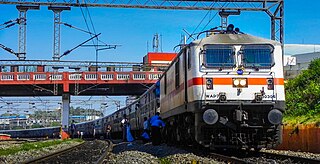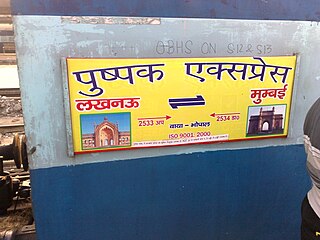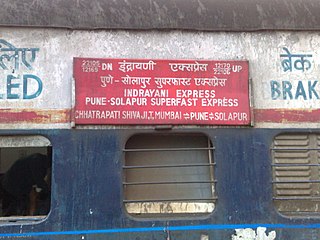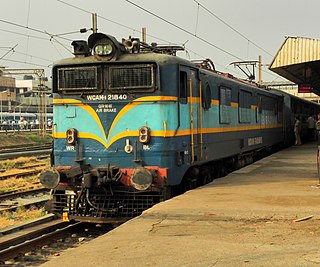
An electro-diesel locomotive is powered either from an electricity supply or by using the onboard diesel engine. For the most part, these locomotives are built to serve regional, niche markets with a very specific purpose.

The Indian Railways primarily operates fleet of electric and diesel locomotives, along with several compressed natural gas (CNG) locomotives. Steam locomotives are operated on a few World Heritage sites and also run occasionally as heritage trains. A locomotive is also known as a loco or engine. The country's first steam locomotive ran on the Red Hill Railway from Red Hills to the Chintadripet bridge in Madras in 1837.

The Indian locomotive class WAM-4 is a class of 25 kV AC electric locomotives that was developed in the 1970 by Chittaranjan Locomotive Works for Indian Railways. The model name stands for broad gauge (W), AC Current (A), Mixed traffic (M) engine, 4th generation (4). They entered service in March 1971. A total of 500 WAM-4 were built at CLW between 1970 and 1983, which made them the most numerous class of mainline electric locomotive till its successor the WAG-5.
Railway electric traction describes the various types of locomotive and multiple units that are used on electrification systems around the world.

Pushpak Express (12533/12534) is a Superfast express train belonging to Indian Railways that run between Lucknow Junction and Mumbai in India. It operates as train number 12533 from Lucknow Junction to Mumbai CSMT and as train number 12534 in the reverse direction.

The 12951/12952 Mumbai Rajdhani Express is a super fast express train of Rajdhani class belonging to Indian Railways that runs between Mumbai Central (MMCT) and New Delhi (NDLS) in India. It is the second fastest Rajdhani service in all of India, surpassed by only the Bandra Rajdhani, with an average running speed (ARS) of nearly 88 km/h. It was introduced on 17 May 1972 between the then Bombay Central (MMCT) and New Delhi. The train became so popular that prior to the introduction of current reservation facility its reservation chart was prepared just 15 minutes before the scheduled departure of the train. It is a daily service. It operates as train number 12951 down from Mumbai Central to New Delhi and as train number 12952 up in the reverse direction.The train has been portrayed in the film The Rajdhani Express.

WAG is a code given by Indian Railways to a series of electric locomotives, run in India. W stands for broad gauge, A for AC traction and G for Goods duty/Freight. They are the most powerful locomotives in the country yet. There are 9 base WAG models with each model has further variations.

The 12927/12928 Mumbai Central Vadodara Vadodara Express is a super fast express train belonging to Indian Railways that runs between Mumbai Central and Vadodara in India. It is a daily service. It operates as train number 12927 from Mumbai Central to Vadodara and as train number 12928 in the reverse direction.

The 22105/22106 Indrayani Superfast Express is a superfast express train belonging to Indian Railways that runs between Mumbai CSMT and Pune Junction in India.

The Jaipur Superfast is one of the most important train of Western railway running between Mumbai in Maharashtra and Jaipur in Rajasthan, India. It is the fastest train under Superfast category of trains; which are running between these two cities. The train has been upgraded with comfortable LHB coaches effectively from 1 November, 2019.

The Indian locomotive class WCAM-1 is a class of Bi-current electric locomotives that was developed in the 1972 by Chittaranjan Locomotive Works for Indian Railways. The model name stands for broad gauge (W), DC Current (C), AC Current (A), Mixed traffic (M) locomotive, 1st generation (1). They entered service in March 1973. A total of 54 WCAM-1 were built at CLW between 1973 and 1979, which made them the most numerous class of mainline dual-power AC-DC electric locomotive.

WCAM-2 is a class of locomotives used in the Indian Railways system. They are the second of the WCAM series. They use the same motors as WCAM 1 but with different circuitry and gearing. They are operational in routes around Mumbai. MU operation was possible with 3 units. WCAM-2P was the passenger oriented version of WCAM-2 class. However they perform better than WCAM 1 series. Same as WCAM 1 class they also performed poorly in DC mode compared to AC mode. They were also used for hauling trains away from the DC section of suburban trains to AC section and performed the same task as the WCAM-1 did. WCAM-2 locos had the same traction motors, as the WCAM-1 locos, but different circuitry and gearing. The bogies are somewhat different from those of the WCAM-1 being fabricated trimount Co-Co bogies with secondary suspension. Rated speed 105 km/h in DC mode and 120 km/h in AC mode.. Almost all of these were dual-braked, but all are now equipped with air brakes only. All the WCAM-1's and -2's were homed at Valsad shed in Gujarat. Many of CR's WCAM-2 locos were not used much in DC zones as they delivered very poor performance in DC mode and on CR's heavy grades. Although these locos have the same traction motors as the WAM 4 and WCAM 1, the power output from the WCAM-2 locos is higher than for the WAM-4 and WCAM-1 because in those models the traction motors were underfed and did not yield their potential maximum power. Under AC traction, the WCAM-2 locos operate with all six motors in parallel, while in DC mode they also operate in the all-series and series-parallel configurations. Recent WCAM-2's from BHEL, including the passenger-specific version WCAM-2P, were rated 2900 hp in DC mode and 4700 hp in AC mode. These were used by WR and CR for fast trains, running at up to 120 km/h. CR had tried the WCAM-2 and WCAM-2P units but found them usable only with speed restrictions. Some WCAM-2P units had only air brakes. With the WCAM-2 locos, MU operation was possible with up to 3 (4?) units. Some (all?) of the WCAM-2 locos were originally leased to IR, ownership remaining with BHEL, the manufacturers.

Igatpuri railway station serves Igatpuri in Nashik district in the Indian state of Maharashtra. It stands at the head of Thull Ghat.

The 12105/12106 Vidarbha Superfast Express is a Super fast express train belonging to Indian Railways - Central Railway zone that runs between Mumbai CSMT and Gondia in Maharashtra. It is a daily service. It operates as train number 12105 from Mumbai CSMT to Gondia and as train number 12106 in the reverse direction.
The Mumbai Dadar–Solapur section is part of the Mumbai-Chennai line. It connects Mumbai Dadar and Solapur both in the Indian state of Maharashtra.

WCAM–3 is a class of dual-power AC/DC series locomotives used in the Indian Railways system. They are the third of the WCAM series. They were specifically designed for use by Central Railways in the Ghat section towards Nashik and Pune.

Electric Loco Shed, Kalyan is an electric engine shed located in Kalyan in the Indian state of Maharashtra. Located east of Kalyan Junction railway station, it falls under the Mumbai CR railway division.
Valsad Electric Loco Shed is an electric engine shed located in Valsad, in the Indian state of Gujarat. It is located to south of Valsad railway station, it falls under the Mumbai WR railway division of Western Railway. It is the largest of locomotive sheds in the Western Railway zone.
Vadodara Electric Loco Shed is an electric engine shed located in Vadodara, in the Indian state of Gujarat. It is located to south of Vadodara railway station, it falls under the Vadodara railway division of Western Railway. It is the largest of locomotive sheds in the Western Railway zone. The shed is controlled by Sr. DEE TRS who is highest authority in the shed with a team of other four officers ( DEE TRS, DEE TRS 1, AEE TRS 1, AEE TRS 2 .At present the shed houses 234 locomotives, which include WAP 4, 72 in no.s, WAP-5, 77 in no.s, WAP 7, 50 in numbers, WAG 5, 35 in no s, locomotives.

WCAG–1 is a class of dual-power AC/DC series locomotives used in the Indian Railways system. They are the only class of the WCAG series. They were specifically designed for use by Central Railways in the Ghat section towards Nashik and Pune.























